The Apple iPad Air 2 Review
by Joshua Ho on November 7, 2014 9:30 AM EST- Posted in
- Tablets
- Apple
- Mobile
- iOS
- ipad Air 2
Display
While the display is important on a smartphone, by virtue of its sheer size tablets seem to have a more critical need for a good display. With a tablet there’s a great deal more potential for usage models such as drawing/sketching and photo/video editing. In addition, reading books or watching videos is far more common on a tablet, which means that poor resolution, response time, and/or contrast can be quite visible and painful to live with. In order to test this, we use our standard suite of tools, which include SpectraCal’s CalMAN 5 and X-Rite’s i1Pro2 spectrophotometer to make sure that our color readings are as accurate as possible. Colorimeters in practice have varying levels of color accuracy due to their design, and as a result these are only used to verify contrast and gamma curves. As previously mentioned, we test against sRGB gamut as it’s the de facto standard for displays and web content. It’s definitely not a perfect standard by any means, but until a wider gamut becomes standard it’s the one to test against.
Before we get into the objective tests though, there’s a lot of talk about that isn’t easily measured. On the simpler side, the display resolution where I can see a noticeable difference when compared to the iPhone 6 Plus and similarly high resolution devices. The 2048x1536 resolution is nothing to be ashamed of, but when stretched to a 9.7 inch display this means that it’s relatively easy to notice pixelated areas on various curves. At a normal viewing distance though it’s not an obvious issue and I didn’t have any issues with eye strain. There could be some value to going to higher resolutions for the iPad Air 3, but barring some major breakthrough in TFTs or backlight technology such a move would incur a significant cost in power due to losses in backlight efficiency as the LEDs approach maximum power draw.
Speaking of LEDs at maximum power draw, outdoor visibility is often a critical use case. While we focus on maximum brightness, in truth this is really just one part of the equation as high reflectance can effectively erase all of the gains that one can have from higher brightness. Unfortunately, I don’t have the proper equipment to objectively test this, although the test will be ready for next year. In practice, I can definitely see a difference in mirror/specular reflections on the tablet when comparing the Galaxy Note 4, although it’s harder to tell when comparing against the iPhone 6. I can definitely see a difference in what is reflected though, as there’s a noticeable purple hue to white reflections in certain angles which could be a magnesium fluoride coating similar to what one might find on glasses or camera lenses. There’s no obvious flaring issues though, and in practice I don’t see any real degradation of clarity. The improvement from the iPad Air is dramatic, especially as the addition of lamination makes the display noticeably closer to the glass and reduces the reflections that result from the air gap. This change also helps with the viewing angles on the iPad Air 2, which were already quite good with the iPad Air due to the chevron-shaped subpixels. As I said with the iPhone 6 review, this helps to ensure that there's much less color shifting when changing viewing angle, although there is a noticeable shift towards purple in some viewing angles which is mostly noticed on pure black but hard to see in any other case.
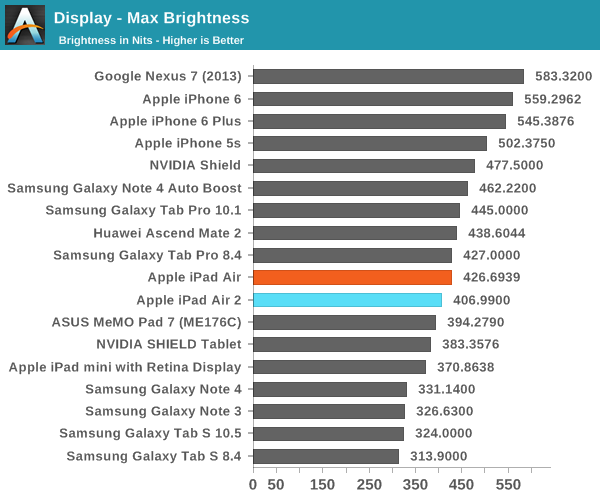

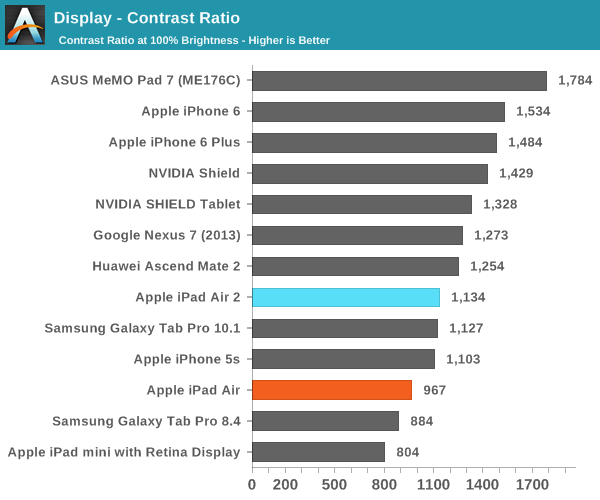
On the actual display characteristics though, we don’t see too much of a difference. Brightness and contrast are quite close to the original iPad Air, which suggests that we’re looking at the same exact display, although production variances may have an effect on things.
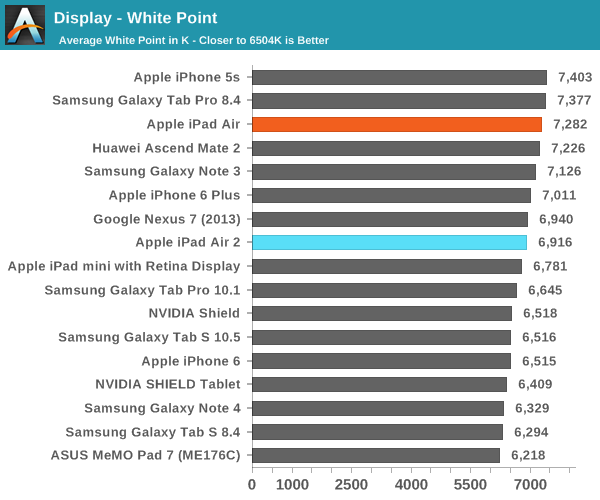
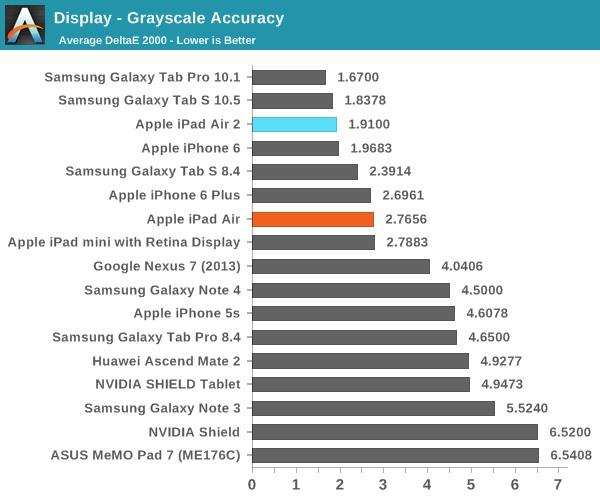
In grayscale, we see some level of improvement to the calibration, although it’s hard to tell whether this is the product of production variance or some level of improvement. In practice grayscale tones are definitely well-rendered, and the blue tint isn’t really significant here. There’s really nothing else to be said, as the visible difference from a reference monitor would be difficult, if not impossible to spot.

For the saturation sweep, which is the next aspect under test we see a similar pattern. While there’s some oversaturation on the blues, there aren’t any other significant issues. The display on the iPad Air 2 is probably similar, if not the same type as the one we’ve seen in the iPad Air as both have the same gamut.
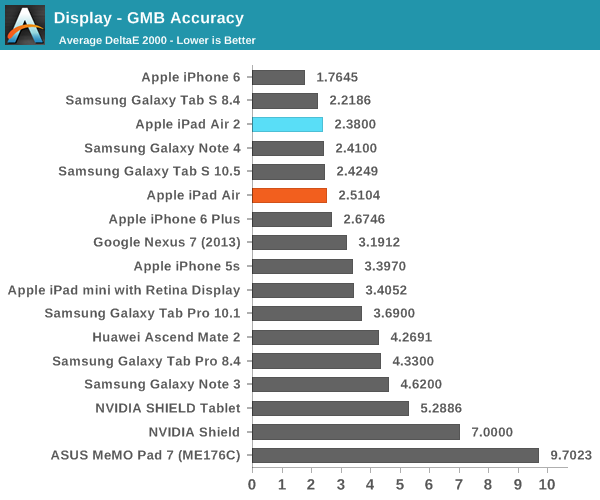
On the GMB ColorChecker, we can generally pick out any issues with display calibration that the saturation sweep won’t show as this test emphasizes hue comparisons along with some grayscale testing. In practice, the iPad Air 2 doesn’t have any issues here as evidenced by the low average error. While there’s noticeable blue shift on some of the hues this shouldn’t be a major problem.
Overall, the quality of the display calibration in the iPad Air 2 is pretty much as good as it gets. While I can name some problems, they’re all minor at best and effectively nit-picking. The fact that I can say this about a tablet display is definitely good news for the state of the industry, as things haven’t quite devolved into a race to the bottom with corners cut in every possible area.
There are some issues with the display overall in terms of peak luminance, but these are likely to be due to the larger display size. These differences when compared to smaller smartphone displays are likely to be due to issues with scaling of the thin film transistor technologies common in smartphone-size displays to tablet-size displays as LTPS backplanes become increasingly expensive to make due to the higher variability involved in the process when compared to IGZO and amorphous silicon processes. Unfortunately, an IGZO backplane seems to gate performance in some key areas as we don’t quite see the levels of brightness and contrast that we do on the iPhone 6 despite lower pixel density.





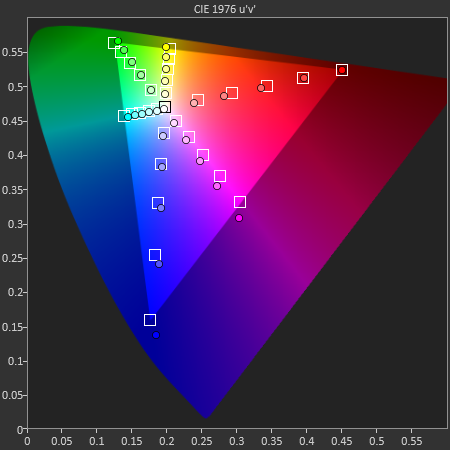
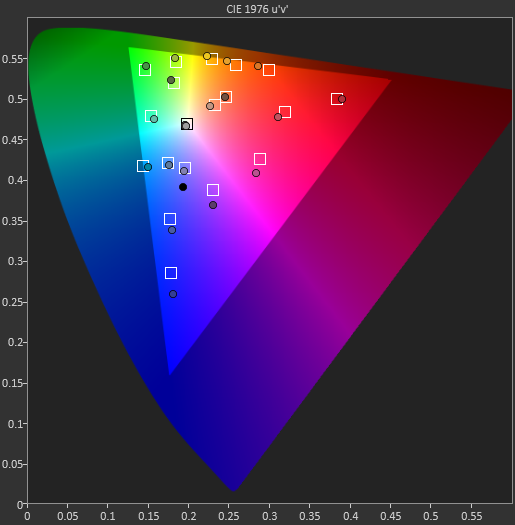








226 Comments
View All Comments
Speedfriend - Friday, November 7, 2014 - link
When I read about the A8, it make me wonder about the A7. With the A8 Apple claims to have improved energy efficiency over the A7 by 50%. Now a iPhone 6 Plus driving a 1920x1020 screen has the same 10 hour battery life as a Galaxy Note 3 which also has a 1920 x 1080 screen. But that means that if Apple had tried to build a phablet with the A7, they would have ended up with a battery life of around 6.5 hours, clearly not competitive with Samsung’s offerings.So to me it looks like Apple didn’t build a bigger screen phone before not because they didn’t feel there was demand but because they simply wouldn’t have been able to compete on battery life and that is why the whole focus with the A8 was improving efficiency rather than simply performance.
So was the A7 just very uncompetitive to other ARM designs or is iOS inefficient compared to Android.
I would love to see someone do some digging on this – Anandtech?
dmunsie - Friday, November 7, 2014 - link
I don't think this has anything to do with either the A7 design or iOS -- there are too many variables in the equation to definitively say. Plus unlike other ARM designs and Android, there is only one source for the A7 and iOS -- Apple. So you can't just take iOS and install it on the same hardware as another Android device and compare.The A7 was also used in the iPad and iPad mini last year where it got an advertised 10 hour battery life. If Apple had made a Plus sized iPhone last year, they probably would've had to make it thicker to get to their target battery life, which is probably similar to what Samsung has done with their designs. Apple never likes to go thicker if they can avoid it.
You can see how Apple values size over battery life because with the move to the A8X, the Air 2 got thinner with the same battery life vs staying the same size but with more battery life. Not saying that valuing battery live over size is better than what Apple chose, but they are clearly making it known what they are optimizing for here.
Impulses - Friday, November 7, 2014 - link
As an Android fan, I'd love to see Apple stop chasing thinness and actually improve battery life by a large degree... They could've done so with the iPhone 6 and chased the claim of "2 day battery life", but they chose thinness instead.Having Apple claiming two day battery life on a phone and destroying everything else by a large margin would definitely light a fire under everyone... Over engineering for 7mm thickness vs 8.5 mm seems quite pointless to me, anything under 9 is quite enough on a phone.
It seems structurally speaking they're better off to, e.g. bendgate...
sonicmerlin - Friday, November 7, 2014 - link
Personally I'd like my phone to be as thin as a credit card.akdj - Thursday, November 27, 2014 - link
Be state came and went in ten minutes. It's a non issueMight check those up times on the 6+ again. They reflect almost identical performance as mine. I could go two days, easily.
Speedfriend - Monday, November 10, 2014 - link
Except the note and the iPhone 6+ have the same size battery, so samsung hasn't had to use a bigger battery to get the same battery life.techconc - Friday, November 7, 2014 - link
You "analysis" fails to consider the size of the battery in existing devices as part of the equation. Likewise, your conclusion regarding the A7 design not being competitive is completely baseless. What's more, you also fail to consider the manufacturing process as a variable as well. The primary efficiency difference between the A8 and A7 has much more to do with the manufacturing process moving from 28nm to 20nm.Finally, if you wish to compare Apple's chips with the competition or iOS vs. Android in terms of efficiency, you should ask yourself why Android phones require more memory to perform the same tasks and why Android devices need such a bigger battery in order to get the same level of usage and/or performance.
Speedfriend - Monday, November 10, 2014 - link
At techconcBattery size is almost identical. Manufacturing process has absolutey nothing to do with it. Or the efficiency difference between A8 and A7. It is a fairly simply equation - at same battery size, A8 equipe diPhone 6+ gives smae battery life as Note 3/4. Swap out A8 for A7 and you would get 1/3 less battery life based on Apple's 50% A8 over A7 efficiency claim. Hence why no big iPhone before.
tipoo - Friday, November 7, 2014 - link
Yup, when I saw the teardown with two RAM banks rather than the usual one, I was expecting 25.6GB/sec, with double the pins/bits going into the SoC. And it also makes sense with the huge GPU gains, something has to feed that beast. Crazy, that's now in laptop bandwidth range.cynic783 - Friday, November 7, 2014 - link
and we made it about 10 comments before the "Anand is an Apple shill" accusation lol. so much Android butt hurt.